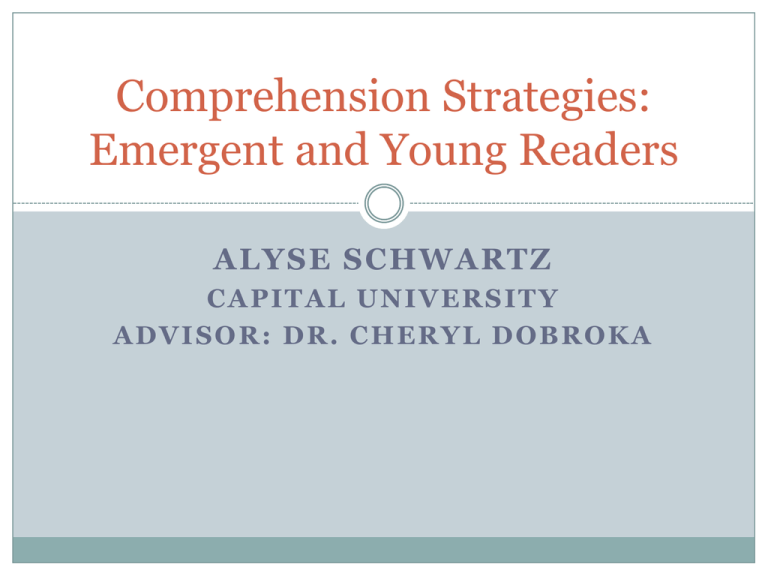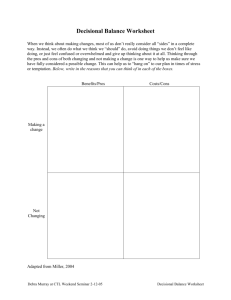Comprehension Strategies: Emergent and Young Readers
advertisement

Comprehension Strategies: Emergent and Young Readers ALYSE SCHWARTZ CAPITAL UNIVERSITY ADVISOR: DR. CHERYL DOBROKA My Experience *Charter School *Content Area Reading Strategies *Three Students *Literacy at home *Individualized Education Plans (IEP) *Computer Based Learning Goal Increase reading comprehension through use of comprehension strategies Key Terms Scaffolding Modeling Explicit Instruction Active Engagement Accommodation and Assimilation Encoding and Decoding Differentiation Encoding and Decoding Decoding-Ability to read Encoding-Comprehending what is read Differentiation Each student is an individual-make the classroom work for everyone High Quality Instruction! Example of Differentiation Accomodation and Assimilation Accomodation-Changing what we know to add new information Assimiliation-Adding information to what we already know Active Engagement Involving students Hands-on Not lecture based Scaffolding Providing support to a student and slowly moving away from the amount of support given as student acquires skill Explicit Instruction Direct Engaging Modeling Setting purpose Comprehension Strategies Using Resources Note-taking Graphic Organizers Reading Guides Multiple Modalities Read Alouds High 5! Making Connections Games Comprehension Strategies Continued Using Resources Vocabulary Acquisition-DIRECT INSTRUCTION Examples: Thesaurus, glossary, “fact finder” Pros Cons/Consider ation *Independence *Teach each resource one at a time Note Taking Remember and Recall Directly teach and practice Examples: Guided Notes Pros * Reference tool Cons/Consider ations *Teach paraphrasing Modeling How to take good notes! 1. Write the date at the top of your paper 2. Write the subject (Social Studies, Math, etc.) 3. Write what you are learning about in each subject 4. Write down key words and their definitions *Many times key words are words that are highlighted or in bold font. Other times, you can find key words by looking for words that are in the book more than one time. 5. Write neatly and give spaces in between each definition and word. 6. Write down examples to help you remember how to complete a problem (This is especially helpful in math!) Different ways to take notes: 1. Number or letter your notes 2. Highlight words in your notes 3. Use bullets or stars in your notes 4. Use charts *There are lots of different ways to take notes, try different ways and see what you like best! Graphic Organizers Visually organizing information Examples: Timelines, Venn Diagrams, Semantic Maps Pros *Makes abstract concrete Cons/Consider ations *Select appropriate organizer Example of Graphic Organizer Reading Guides and Questioning Follow along with text-active process Key information Review and Discuss Pros *Own words *Combine reading and writing Cons/Consider ations *Literal Questions *Guided Notes Example of Pre-Reading Guide Example of During-Reading Guide Multiple Modalities & Making Connections Text to…. Prior knowledge Experiences Text/Pictures/Videos Pros *Attention *Engagement Cons *None Read Alouds & Shared Reading Young and emergent readers who are unable or in the early stages of learning to read Pros Cons/Consider ations *Oral Language *Dependency on *Vocabulary others or *Print Awareness computer *Phonological Awareness High 5! Background knowledge Questioning Text structure Mental Images “Making pictures in our head!” Summarizing Pros *Combination of strategies Cons/Consider ations *Mental imagery is difficult High 5! Strategy Continued 1. Activate background knowledge 2. Questioning 3. Analyzing text structure 4. Creating mental images 5. Summarizing Making comprehension fun Reiterates previously learned concepts Examples: Games, Online Books Pros *Engaging *All ability levels Cons/Consider ations *Overuse Effectiveness of Strategies with my students What I Learned Use multiple strategies! Teach one strategy at a time Consider Zone of Proximal Development Each strategy will work differently for each student and each text Future Planning: What I still want to learn Other fun methods to teach and incorporate comprehension strategies Objectively assess reading comprehension Increase parent-involvement Creating a print-rich environment Key to Reading Comprehension Tell me and I’ll forget; show me and I may remember; involve me and I’ll understand”-Chinese Proverb






